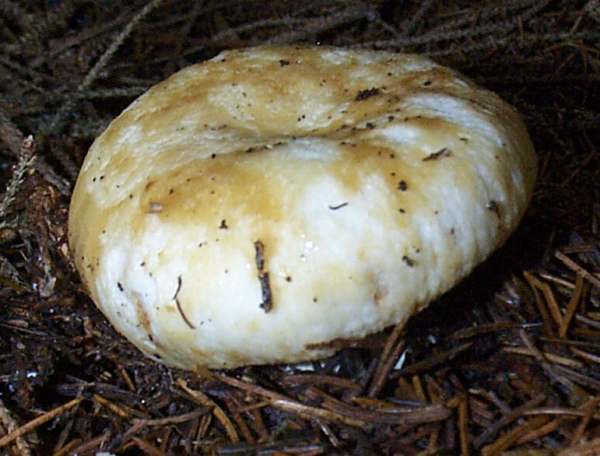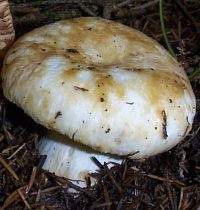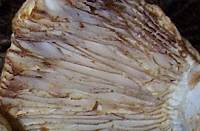Russula illota Romagn. - Freckled Brittlegill
Phylum: Basidiomycota - Class: Agaricomycetes - Order: Russulales - Family: Russulaceae
Distribution - Taxonomic History - Etymology - Identification - Culinary Notes - Reference Sources

Russula illota (syn. Russula laurocerasi var. illota) is an untidy fungus, usually damaged before it emerges from the forest floor, and very often with a hole in the cap through to the centre of the hollow stipe.
The macroscopic characters of this brittlegill differ very little from those of Russula grata and Russula foetens, and confident separation of these three very similar species is difficult and usually requires microscopic examination.
Distribution
This scruffy brittlegill is rare in Britain, as it is also in many other parts of Europe. The Freckled Brittlegill is recorded as occurring also in North America.
Taxonomic history
The Freckled Brittlegill was described in 1954 by French mycologist Henri Charles Louis Romagnesi (1912 - 1999), who gave it the scientific name Russula illota by which it is generally recognised today.
Etymology
Russula, the generic name, means red or reddish, and indeed many of the brittlegills do have reddish caps (but many more of the brittlegill mushrooms are not red, and several of those that are usually red can also occur in a range of other colours!).
The specific epithet illota means dirty or unwashed - a reference to the freckled appearance of caps of this brittlegill.
Identification guide
 |
Cap5 to 10cm in diameter and more or less flat or slightly depressed in the centre when fully developed, the caps are spherical when young. Honey brown and rather blotchy, the cap surface is viscid and develops intense radial ridges. |
 |
GillsThe narrow, adnexed gills are moderately close together; they are very brittle. Initially cream, the gills darken with age and their edges develop violaceous-brown 'dots and dashes'. Stem15 to 35mm in diameter and 4 to 8cm tall, the stems are white and solid, developing internal cavities; vinaceous-brown dashes devlelop longitudinally down the stems as they age. |
SporesEllipsoidal, 8-9 x 6.5-7.5µm, ornamented with sharp warts up to 1.2µm tall with a few connecting lines but not forming a reticulum. Spore printCream. |
|
Odour/taste |
Very variable (often in between Russula grata and Russula foetens) and so not generally of much help with identification. |
Habitat & Ecological role |
Coniferous and broad-leaf woodland, most often on chalky soil. In common with other members of the Russulaceae, Russula illota is an ectomycorrhizal mushroom. |
Season |
August to November in Britain and Ireland. |
Similar species |
Russula grata and Russula foetens are similar to Russula illota in appearance, habitat and season. Few people can tell these three fungi apart with any certainty without resorting to microscopic examination. |
Culinary Notes
Russula illota is thought to be inedible.
Reference Sources
Pat O'Reilly (2016). Fascinated by Fungi, First Nature Publishing
Geoffrey Kibby (2011).The Genus Russula in Great Britain, published by G Kibby.
Roberto Galli (1996). Le Russule. Edinatura, Milan.
English Names for fungi; British Mycological Society, 2013.
Dictionary of the Fungi; Paul M. Kirk, Paul F. Cannon, David W. Minter and J. A. Stalpers; CABI, 2008
Taxonomic history and synonym information on these pages is drawn from many sources but in particular from the British Mycological Society's GB Checklist of Fungi.
Fascinated by Fungi. Back by popular demand, Pat O'Reilly's best-selling 450-page hardback book is available now. The latest second edition was republished with a sparkling new cover design in September 2022 by Coch-y-Bonddu Books. Full details and copies are available from the publisher's online bookshop...

